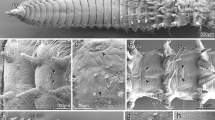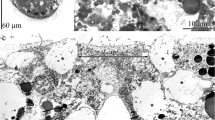Abstract
Using characters discernible through electron microscopy, we redefine the organ traditionally identified as the frontal organ in acoelomorph turbellarians as being a collection of two to several large mucus-secreting glands whose necks emerge together through a frontal pore at the exact apical pole of the body, i.e. at the point where the pattern of epidermal ciliary rootlets converges. Representatives that we have studied of each of the acoel families Paratomellidae, Diopisthoporidae, Solenofilomorphidae, Convolutidae, Otocelidae, and Mecynostomidae, as well as a representative of the Nemertodermatida, have such glands. Up to five additional types of glands that open anteriorly outside of the frontal pore, some of which are indistinguishable from glands of the general body wall, could be seen in the nemertodermatid, in Hesiolicium inops (Paratomellidae), and in representatives of the latter four acoel families. In Paratomella, three different types of glands open in diffuse fashion in a frontal glandular complex reminiscent of that in the Macrostomida.
Sensory elements near the frontal pore appear to be independent of the gland necks, and so the organ cannot be considered a sensory organ.
The frontal organ, as described above, appears very likely to be homologous within the Acoelomorpha, and represents another strong (although unrooted) autapomorphy for this line of turbellarian evolution.
Similar content being viewed by others
References
Antonius, A., 1968. Faunistische Studien am Roten Meer im Winter 61/62: Teil IV: Neue Convolutidae und eine Bearbeitung des Verwandschaftskreises Convoluta (Turb.: Acoela). Zool. Jb. Syst. Biol. 92: 297–394.
Antonius, A., 1970. Sense organs in marine Acoela. Am. Zool. 10: 550.
Bush, L. F., 1981. Marine flora and fauna of the northeastern United States. Turbellaria: Acoela and Nemertodermatida. NOAA Technical Report NMFS Circular 440.
Crezee, M., 1975. Monograph of the Solenofilomorphidae (Turbellaria: Acoela). Int. Revue ges. Hydrobiol. 60: 769–845.
Crezee, M. & S. Tyler, 1976. Hesiolicium gen. n. (Turbellaria, Acoela) and observations on its ultrastructure. Zool. Scr. 5: 207–216.
Dörjes, J., 1968. Die Acoela (Turbellaria) der Deutschen Nordseekuste und ein neues System der Ordnung. Z. zool. Syst. Evolutionsforsch. 6: 56–452.
Duffy, E. & S. Tyler, 1984. Quantitative differences in mitochondrial ultrastructure of a thiobiotic and an oxybiotic turbellarian. Mar. Biol. 83: 95–102.
Ehlers, U., 1984. Das Phylogenetisches System der Plathelminthes. Habilitationsschrift, Fach Zoologie im Fachbereich Biologie, Georg-August-Universität zu Göttingen.
Faubel, A., 1976. Interstitielle Acoela (Turbellaria) aus dem litoral der nordfriesischen Inseln Sylt und Amrum (Nordsee). Mitt. Hamb. Zool. Mus. Inst. 73: 17–56.
Faubel, A. & J. Dörjes, 1978. Flagellophora apelti gen. n. sp. n.: A remarcable [sic] representative of the order Nemertodermatida (Turbellaria: Archoophora). Senckenbergiana marit. 10: 1–13.
Klauser, M., J. Smith & S. Tyler, 1985. Ultrastructure of the frontal organ of Convoluta ‘pulchra’ and Macrostomum spp.: significance for models of the turbellarian archetype. Hydrobiologia. This volume.
Klose, R., 1984. Organogenesis of the frontal gland complex during paratomy in Paratomella sp. (Turbellaria, Acoela). M.S. Thesis, University of Maine at Orono.
Smith, J. P. S., 1981. Fine-structural anatomy of the parenchyma in the Acoela and Nemertodermatida (Turbellaria). Ph.D. dissertation, University of North Carolina, Chapel Hill.
Smith, J. & S. Tyler, 1984. Serial-sectioning of resin-embedded material for light microscopy: recommended techniques for micrometazoans. Mikroskopie 41: 259–270.
Smith, J. & S. Tyler, 1985a. The acoel turbellarians: kingpins of metazoan evolution or a specialized off-shoot? In S. Conway Morris, J. D. George, R. Gibson & H. M. Platt (eds), Origins and relationships f of lower invertebrates. University Press, Oxford.
Smith, J. & S. Tyler, 1985b. Fine-structure and phylogeny of the frontal organ in Turbellaria Acoela: 1. Diopisthoporus gymnopharyngeus, n. sp. Zool. Scr. 14: 91–102.
Smith, J., S. Tyler & R. M. Rieger, 1985. Is the Turbellaria Polyphyletic? Hydrobiologia. This volume.
Sterrer, W., 1965. New polylithophorous marine turbellaria. Nature 210: 436.
Von Graff, L., 1891. Die Organisation der Turbellaria Acoela. Leipzig 1891.
Westblad, E., 1948. Studien uber Skandinavische Turbellaria Acoela V. Ark. Zool. 41A: 1–82.
Author information
Authors and Affiliations
Rights and permissions
About this article
Cite this article
Smith, J.P.S., Tyler, S. Frontal organs in the Acoelomorpha (Turbellaria): Ultrastructure and phylogenetic significance. Hydrobiologia 132, 71–78 (1986). https://doi.org/10.1007/BF00046231
Issue Date:
DOI: https://doi.org/10.1007/BF00046231




